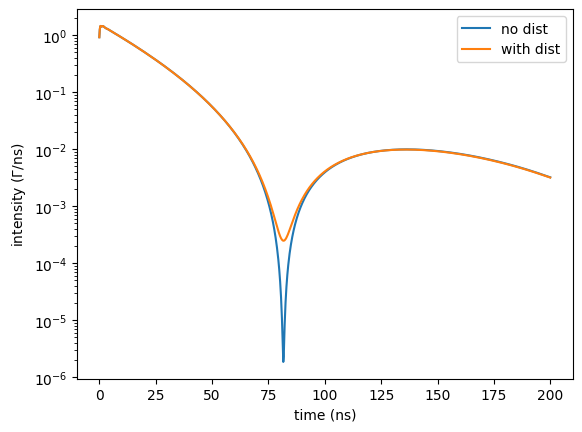Thickness and divergence distributions
A thickness distribution of the layers in a sample or the beam divergence onto the sample have to be treated specially as the intensities have be added incoherently (with a typical partly coherent beam of a synchrotron).
A layer has the thickness_fwhm attribute specifying the full width half maximum of a thickness distribution around the layer thickness.
The sample has the divergence attribute specifying the full width half maximum of an angular distribution around the incidence angle of the beam on the sample.
To take these distributions into account you must specify distribution_points to larger than one in the corresponding measurement method.
Note
By default Nexus does not use thickness or divergence distributions.
Thickness distributions are typically observed in time spectra when the hyperfine interactions are small and dynamical effects are present. Therefore, we use an enriched stainless steel foil without any hyperfine interactions.
# import packages
import nexus as nx
import numpy as np
import matplotlib.pyplot as plt
layer_SS = nx.Layer(id = "Stainless steel",
material = nx.Material.Template(nx.lib.material.SS_enriched),
thickness = 3000, # in nanometer
thickness_fwhm = 300) # in nanometer
site = nx.Hyperfine()
layer_Fe.material.hyperfine_sites = [site]
sample = nx.Sample(layers = [layer_SS])
beam = nx.Beam()
beam.LinearSigma()
exp = nx.Experiment(beam = beam,
objects = [sample],
isotope = nx.moessbauer.Fe57)
time_spectrum = nx.TimeSpectrum(experiment = exp,
time_length = 200,
time_step = 0.2,
distribution_points = 1) # no distribution used, the default value
time_axis, intensity = time_spectrum.Calculate()
plt.semilogy(time_axis, intensity, label='no dist')
# now with distribution
time_spectrum.distribution_points = 31
plt.semilogy(*time_spectrum.Calculate(), label='with dist')
plt.legend()
plt.xlabel('time (ns)')
plt.ylabel('intensity ($\Gamma$/ns)')
plt.show()

The same holds for the beam divergence onto a sample. The beam divergence is especially important while fitting time spectra in thin film cavities with strong dynamical effects.
For experiments with several samples and combined thickness distributions in forward geometry and beam divergences in gracing incidence geometry, the same distribution points number is used for all distributions in the experiment.
Note
This parameter must be specified for each measurement you set up.
If you want to fit several measurements simultaneously with thickness and/or beam divergence distributions set the distribution_points to the same value for all measurements in the fit.